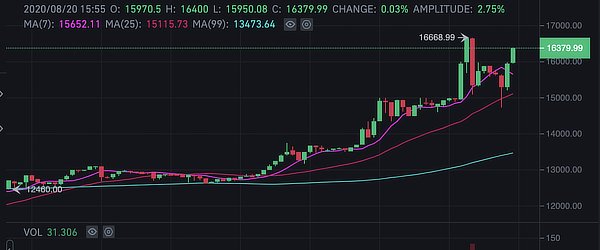
2020-9-4 12:35 |
The hottest thing to emerge for Ethereum holders this week has been Yearn Finance’s yETH high-yield farming pool. It has survived its first tribulation as ETH prices dumped 14% on the day.
This week, Yearn Finance’s DeFi platform, which recently launched insurance incentives, unveiled two new high yielding vaults for Ethereum holders. One is for ETH and the other for wETH (wrapped Ethereum).
It has been called a ‘beast for ETH stacking,’ and a ‘black hole for ETH,’ by industry experts suggesting that once Ethereum has been deposited, holders will be reluctant to withdraw it and lose out on such impressive yields.
Within the first day of launch, over $100 million in liquidity had been deposited, which worked out to be more than 230,000 ETH at the time. Vault yields were as high as 95% APY, which would almost double the ETH deposited in a year.
Yearn Vault Inner-WorkingsThe vaults use collateral deposited in ETH or wETH to mint Dai from a MakerDAO smart contract using a collateralized debt position (CDP) at a 200% collateralization ratio. This is to protect it from liquidation should the price of ETH go down, which it has done quite violently over the past 24 hours.
In reaction to the launch, MakerDAO governance proposed an executive vote to increase the ETH debt ceiling from 420 million to 540 million. This would effectively enable more Dai to be minted for use in these DeFi vaults. Industry analysts observed that this was also bullish for MakerDAO and Dai.
The Dai stablecoin is then deposited in the yDAI vault and used as collateral on the high-yield Curve.fi Y liquidity pool to generate CRV. This is a stablecoin pool consisting of unequal weights of DAI, USDC, USDT, and TUSD, returning yCRV tokens representing the stake in the pool.
The yETH vault is now earning trading fees from the Curve pool and staking the yCRV tokens on the Curve DAO in order to farm CRV. The yETH vault periodically sells the CRV tokens for ETH on the open market through decentralized exchanges and deposits that allow ETH to flow back into the vault, increasing all yETH holders’ overall stakes.
The benefit for Ethereum holders and liquidity providers is that they do not have to do a thing and the entire process is automated. There is no need to research the best pools, harvest tokens, or pay gas fees at each transfer. It is basically a case of sitting back and accumulating ETH over time, hence the ‘black hole’ analogy.
This type of strategy would not be possible using traditional finance and is just one example of how the DeFi space has evolved this year.
There are a couple of caveats as usual. Firstly there is a 0.5% withdrawal fee that Yearn Finance imposes. Secondly, gas fees are off the chart at the moment so it will cost relatively more to make the initial deposit and withdrawal. As with most things DeFi related, it benefits the whales more than the minnows.
The third drawback is that it still carries quite a high risk due to the collateralization ratios. As pointed out by Anthony Sassano in his Daily Gwei newsletter this week, the major risk of this strategy is if the MakerDAO CDP falls to below a 150% collateralization ratio due to the price of ETH falling fast.
If this happens, the yETH vault may be liquidated resulting in the loss of ETH for liquidity providers. This would not happen instantly however as there is a mechanism that allows debt repayment. MakerDAO has a built-in system called the oracle security module (OSM) that essentially gives CDP/vault owners one hour to pay down their debts.
Over the past 24 hours, Ethereum prices have dumped around 14% and the yETH vault has not been liquidated, proving that the mechanism is working as intended.
Surviving the First Price CrunchEthereum prices have collapsed from around $450 at the same time yesterday to around $390 at the time of press.
ETH/USD – TradingViewThe move has knocked 14% off the price of Ethereum taking it back to support levels. It has been largely induced by Bitcoin which again failed to break the psychological $12,000 barrier and dumped back to $10,100.
At the time that prices started to plummet, Yearn Finance paused yETH deposits after 70 million Dai had been minted in order to balance between best profits and best risk adjustment.
https://t.co/hHZTAKGK2d update;
Deposits to yETH have been paused. ~70m DAI minted. Withdrawals unaffected. We will allow deposits again in the future. For now this is a high enough cap to balance between best profits and best risk adjustment. pic.twitter.com/te0Z2g6z7G
— yearn.finance (@iearnfinance) September 3, 2020
The yETH vault survived the crunch and has actually increased in terms of liquidity as ETH has got cheaper.
Crypto investor Andrew Kang [@Rewkang] observed how it survived the crash and made three rebalances in order to pay 2.7 million Dai back into the collateralized debt position:
The new @iearnfinance yETH vault absorbed 378k ETH since launching 2 days ago
It also just successfully managed risk during a 25% crash
3 Rebalances were called in the past hour leading to 2.7M DAI paid back to its CDP
Cool validation for the product pic.twitter.com/x32At0P8tq
— Andrew Kang (@Rewkang) September 4, 2020
At the time of press, there was 375,000 ETH deposited in the vault earning around 73% according to Yearn Finance stats.
Ethereum prices may well correct further, but Yearn Finance appears to have its finger on the pulse and has managed one 15% slide without hassle. Additionally, collateral continues to increase in the yETH vault indicating investor confidence in the product.
DeFi Markets Beat a RetreatThe crypto market crash has resulted in the first major decline in DeFi total value locked since March. An all-time high of $9.5 billion was hit on Sept 2 according to DeFi Pulse.
DeFi TVL – DeFi PulseTraders and yield farmers have been pulling out since the top, resulting in an 8% decline to around $8.75 billion. Over the past 30 days, DeFi markets are still up a whopping 92%, so a correction was inevitable.
Uniswap is the top protocol in terms of TVL at the moment with $1.68 billion and a market share of just below 20%. Maker and Aave, coming in second and third places respectively have declined in TVL while Curve and Yearn have increased slightly, mostly due to the yETH vaults launched this week.
Additionally, it appears that yield farmers could be slowly wising up to the dodgy DeFi food meme tokens that have flooded the scene in recent weeks.
The post Yearn’s Ethereum Liquidity Vault Survives First Major ETH Price Dump appeared first on BeInCrypto.
origin »Ethereum (ETH) на Currencies.ru
|
|








